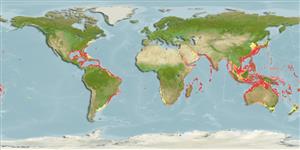Common names from other countries
Environment: milieu / climate zone / depth range / distribution range
بوم شناسي
دريايي نزديك كف زي; تغييرات عمق 30 - 270 m (Ref. 11230). Tropical
Widespread in the Indo-West Pacific: and Atlantic.
Size / Weight / سن
Maturity: Lm ? range ? - ? cm
Max length : 60.0 cm TL جنس نر / بدون خواص جنسي; (Ref. 124490)
مهره ها: 119 - 130. This species is distinguished by the following characters: presence of pectoral fin; dorsal-fin origin is slightly anterior to pectoral-fin base, predorsal length 10.7-13.1% TL; anus anterior, below tip of pectoral fin, preanal length 15.9-18.9% TL; very short trunk, 2.8-5.5% TL; intermaxillary teeth 2; compound teeth on vomer 4; single row of 9-11 large compound teeth on lower jaw; head pores: IO 4, SO 3; M 6; POP 0; AD 1, F 0, ST 0; lateral-line pores: predorsal 3-6, prepectoral 6-9, preanal 8-12, total 57-75, the last at posterior two-thirds of total length; MVF 8-14-124, total vertebrae 119-128 (up to 130 in Robins & Robins, 1989) (Ref. 106136).
Inhabits coastal waters. Prefers muddy bottoms, often off mouths of large rivers.
Life cycle and mating behavior
بلوغ | تولید مثل | تخم ریزی | تخم ها | Fecundity | توزاد ( لارو)
Castle, P.H.J., 1986. Synaphobranchidae. p. 188-190. In M.M. Smith and P.C. Heemstra (eds.) Smiths' sea fishes. Springer-Verlag, Berlin. (Ref. 3973)
وضعيت در فهرست قرمز IUCN (Ref. 130435)
CITES (Ref. 128078)
Not Evaluated
خطر برای انسان ها
Harmless
استفاده انسانی
ماهي گيري – شيلات: از بی علاقه گی
اطلاعات بيشتر
اسامي عاممترادفسوخت و سازشکارچیانسم شناسي بوم زيستيتولید مثلبلوغتخم ریزیFecundityتخم هانمو تخم
مراجعآبزي پرورينمايه آبزي پرورينژادهاژنتيكElectrophoresesوارثبيماري هافرآوریMass conversion
همكارانعکس هاStamps, Coins Misc.صداهاسيگواتراسرعتنوع شناگریمنطقه آبششيOtolithsمغزهابینایی
ابزارها
گزارش های ويژه
بارگيری XML
منابع اينترنتي
Estimates based on models
Preferred temperature (Ref.
115969): 17.2 - 27.6, mean 23.6 (based on 944 cells).
Phylogenetic diversity index (Ref.
82804): PD
50 = 0.5001 [Uniqueness, from 0.5 = low to 2.0 = high].
Bayesian length-weight: a=0.00102 (0.00046 - 0.00225), b=3.06 (2.88 - 3.24), in cm Total Length, based on all LWR estimates for this body shape (Ref.
93245).
Trophic level (Ref.
69278): 4.0 ±0.4 se; based on size and trophs of closest relatives
Fishing Vulnerability (Ref.
59153): Moderate vulnerability (44 of 100).
